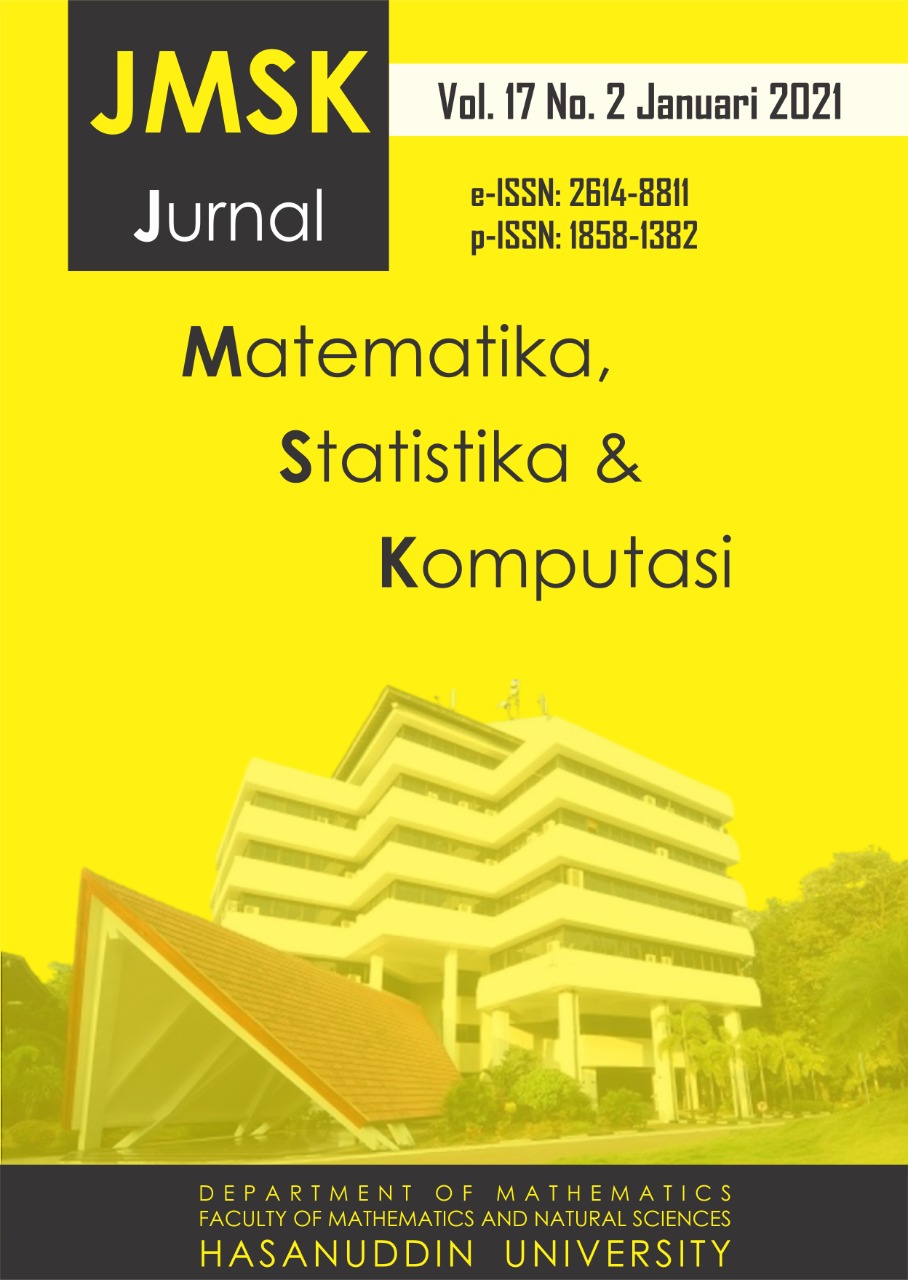Optimization of CV.Amanda Makassar Production Planning in the Time of Covid-19 Using Multiple Goal Linear Program Model
DOI:
https://doi.org/10.20956/jmsk.v17i2.11793Keywords:
Program Linear Tujuan Ganda, Optimasi, LINGOAbstract
A research has been conducted on the use of multiple-goal linear program model to solve multi goals by taking the case of optimization of production planning at CV. Amanda Makassar during the Covid-19 period. In this research, four goals were formulated, that were (i) the fulfillment of the number of market demand, (ii) maximizing income, (iii) minimizing production costs, and (iv) maximizing working hours. Then for the optimal solution using LINGO 18 software. Based on the research results, the optimal production plan during the Covid-19 period resulted from the two different models for original brownies products where the results of the dual-purpose linear program model without target priority produced 16.118 original brownies and 32.400 packages from the dual-purpose linear program model with priority target with weight. For cream cheese brownies, there are 3.000 packages, 18.000 packages of sarikaya pandan brownies, 3.600 packs of choco marble brownies, pink marble brownies, tiramishu marble brownies, roasted brownies, and 1.800 packs of cappuccino marble brownies. Chocolate bananas bolen, pineapple molen, and chocolate ganache in 840 packages. Then for 15.000 packs of blueberry brownies, 960 packs of strawberry brownies, 360 packs of dry brownies, 2.400 banana cheese brownies, 300 packs of cheese bananas bolen, 600 packs of peanut butter, and 9.000 packs of pandan cake for a month. The maximum revenue obtained by the company with a multiple-purpose linear program model without target priority is Rp.628.602.000.- and the minimum production cost that the company must pay is Rp.495,048,300,-. Then for the multiple-purpose linear program model with target priority accompanied by a weight of Rp.4.299.480.000.- and the minimum production cost is Rp.3.394.366.000. The result shows that optimization using a multiple goal linear program model with goal priority provide optimal production which results in greater profit compared to the process (optimization) carried out by the company so far, which is only based on the number of demand.Downloads
References
Damanik, Elikson, dkk. (2013). Penerapan Metode Goal Programming Untuk Mengoptimalkan
Produksi The (Studi Kasus: PT Pekebunan Nusantara IV - Pabrik Teh Bandung), Jurnal Saintia Matematika Vol. 1, No. 2, pp. 117 – 128.
Taha, Hamdy A. (2007). Operation Research: An Introduction. New Jarsey : Person Education, Inc.
Taha, Hamdy A. (1996). Riset Operasi: Suatu Pengantar. Jakarta: Binarupa Aksara
Hapsari, S. N. & Rosyidi, C. N., (2018). A Goal Programming Optimization Model for the Allocation of Liquid Steel Production. IOP Conf. Series:Materials Science and Engineering.
Anggraeni, Wiwik, dkk., (2015). Production Planning Optimization Using Goal Programming Method in Habibah Busana. Journal of Advan Management Sciense, Volume. 3, No. 4.
Adeyeye, A. D. & Charles-Owaba, O. E., (2008). Goal Programming Model for Production Planning in a Toothpaste Factory. South African Journal of Industrial Engineering, Volume 19(2), pp. 197-209.
Kumar, Puligilla Prashanth. (2019). Goal Programming Through Bakery Production, Internasional Journal of Scientific & Technology Research, Volume 8.
Etemadi, S, dkk., (2018). A Goal Programming Capital Budgeting Model Under Uncertainty in Construction Industry. Science Iranica E. 25(2). pp 841-851.
Barbosa, Luis Carlos. & Luiz Flavio Autran Monteiro Gomes., (2015). Assessment of Efficiency and Sustainability in a Chemical Industry using a Goal Programming and AHP. Procedia Computer Science, 55 . pp 165-174
Dhoruri, Atmini, dkk., (2013). A Goal Programming Approach to Solve Vehicle Routing Problem Using Lingo. Proceeding of IICMA.
Halim, Bushra Abdul, dkk., (2015). Bank Financial Statement Management Using a Goal Programming Model. Procedia- Social and Behavioral Science, 211. pp 498-504.
Downloads
Published
How to Cite
Issue
Section
License
Copyright (c) 2020 Author and publisher

This work is licensed under a Creative Commons Attribution 4.0 International License.

This work is licensed under a Creative Commons Attribution 4.0 International License.
Jurnal Matematika, Statistika dan Komputasi is an Open Access journal, all articles are distributed under the terms of the Creative Commons Attribution License, allowing third parties to copy and redistribute the material in any medium or format, transform, and build upon the material, provided the original work is properly cited and states its license. This license allows authors and readers to use all articles, data sets, graphics and appendices in data mining applications, search engines, web sites, blogs and other platforms by providing appropriate reference.








